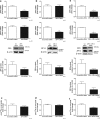Iron uptake by ZIP8 and ZIP14 in human proximal tubular epithelial cells
- PMID: 30806852
- PMCID: PMC6437295
- DOI: 10.1007/s10534-019-00183-7
Iron uptake by ZIP8 and ZIP14 in human proximal tubular epithelial cells
Abstract
In patients with iron overload disorders, increasing number of reports of renal dysfunction and renal iron deposition support an association between increased iron exposure and renal injury. In systemic iron overload, elevated circulating levels of transferrin-bound (TBI) and non-transferrin-bound iron (NTBI) are filtered to the renal proximal tubules, where they may cause injury. However, the mechanisms of tubular iron handling remain elusive. To unravel molecular renal proximal tubular NTBI and TBI handling, human conditionally immortalized proximal tubular epithelial cells (ciPTECs) were incubated with 55Fe as NTBI and fluorescently labeled holo-transferrin as TBI. Ferrous iron importers ZIP8 and ZIP14 were localized in the ciPTEC plasma membrane. Whereas silencing of either ZIP8 or ZIP14 alone did not affect 55Fe uptake, combined silencing significantly reduced 55Fe uptake compared to control (p < 0.05). Furthermore, transferrin receptor 1 (TfR1) and ZIP14, but not ZIP8, colocalized with early endosome antigen 1 (EEA1). TfR1 and ZIP14 also colocalized with uptake of fluorescently labeled transferrin. Furthermore, ZIP14 silencing decreased 55Fe uptake after 55Fe-Transferrin exposure (p < 0.05), suggesting ZIP14 could be involved in early endosomal transport of TBI-derived iron into the cytosol. Our data suggest that human proximal tubular epithelial cells take up TBI and NTBI, where ZIP8 and ZIP14 are both involved in NTBI uptake, but ZIP14, not ZIP8, mediates TBI-derived iron uptake. This knowledge provides more insights in the mechanisms of renal iron handling and suggests that ZIP8 and ZIP14 could be potential targets for limiting renal iron reabsorption and enhancing urinary iron excretion in systemic iron overload disorders.
Keywords: Iron; Non-transferrin-bound iron; Proximal tubular epithelial cell; Transferrin; ZIP14; ZIP8.
Conflict of interest statement
The authors declare that they have no conflicts of interest with the contents of this article.
Figures







Similar articles
-
Molecular mechanisms of non-transferrin-bound and transferring-bound iron uptake in primary hippocampal neurons.J Neurochem. 2015 Jun;133(5):668-83. doi: 10.1111/jnc.13040. Epub 2015 Mar 10. J Neurochem. 2015. PMID: 25649872 Free PMC article.
-
The plasma membrane metal-ion transporter ZIP14 contributes to nontransferrin-bound iron uptake by human β-cells.Am J Physiol Cell Physiol. 2017 Feb 1;312(2):C169-C175. doi: 10.1152/ajpcell.00116.2016. Epub 2016 Nov 30. Am J Physiol Cell Physiol. 2017. PMID: 27903581 Free PMC article.
-
Zip14 (Slc39a14) mediates non-transferrin-bound iron uptake into cells.Proc Natl Acad Sci U S A. 2006 Sep 12;103(37):13612-7. doi: 10.1073/pnas.0606424103. Epub 2006 Sep 1. Proc Natl Acad Sci U S A. 2006. PMID: 16950869 Free PMC article.
-
A holistic view of mammalian (vertebrate) cellular iron uptake.Metallomics. 2020 Sep 23;12(9):1323-1334. doi: 10.1039/d0mt00065e. Metallomics. 2020. PMID: 32766655 Free PMC article. Review.
-
[Roles of Zinc Transporters That Control the Essentiality and Toxicity of Manganese and Cadmium].Yakugaku Zasshi. 2021;141(5):695-703. doi: 10.1248/yakushi.20-00243-5. Yakugaku Zasshi. 2021. PMID: 33952754 Review. Japanese.
Cited by
-
A Systems Biology Approach Towards a Comprehensive Understanding of Ferroptosis.Int J Mol Sci. 2024 Nov 2;25(21):11782. doi: 10.3390/ijms252111782. Int J Mol Sci. 2024. PMID: 39519341 Free PMC article.
-
Iron Deficiency and Nephrotoxic Heavy Metals: A Dangerous Interplay?Int J Mol Sci. 2023 Mar 10;24(6):5315. doi: 10.3390/ijms24065315. Int J Mol Sci. 2023. PMID: 36982393 Free PMC article. Review.
-
Ferroptosis: a new strategy for Chinese herbal medicine treatment of diabetic nephropathy.Front Endocrinol (Lausanne). 2023 Jun 9;14:1188003. doi: 10.3389/fendo.2023.1188003. eCollection 2023. Front Endocrinol (Lausanne). 2023. PMID: 37361521 Free PMC article. Review.
-
Critical Role of Zinc Transporter (ZIP8) in Myeloid Innate Immune Cell Function and the Host Response against Bacterial Pneumonia.J Immunol. 2021 Sep 1;207(5):1357-1370. doi: 10.4049/jimmunol.2001395. Epub 2021 Aug 11. J Immunol. 2021. PMID: 34380651 Free PMC article.
-
Iron Pathways and Iron Chelation Approaches in Viral, Microbial, and Fungal Infections.Pharmaceuticals (Basel). 2020 Sep 25;13(10):275. doi: 10.3390/ph13100275. Pharmaceuticals (Basel). 2020. PMID: 32992923 Free PMC article. Review.
References
Publication types
MeSH terms
Substances
LinkOut - more resources
Full Text Sources
Medical

